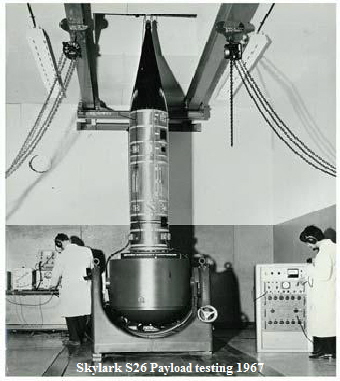|
Following the Comet Aircraft disasters, there was increasing need for heavy duty test equipment and Paul Taylor began to develop what the Americans later called “shakers”, but the UK called “Moving Coil Exciters”.
Pamphonic/Savage already had great experience of huge valve amplifiers and for the “shakers” up to 20kW was required. Paul Taylor made moving coils of huge proportions; some were several metres across the coil, but others, which were used to “shake” equipment like Army tanks, were the size of a house!
 Pamphonic/Savage vibrators were used to test Blue Streak – the rocket at the heart of the UK’s own space programme. They were also used by BAC (British Aircraft Corporation) to test rockets for the European ESRO Skylark scientific rocket programme. The Skylark S26 payload is shown being tested prior to launch in 1967. The violent shaking simulated take-off stresses and weeded out inadequate components and design. Pamphonic/Savage vibrators were used to test Blue Streak – the rocket at the heart of the UK’s own space programme. They were also used by BAC (British Aircraft Corporation) to test rockets for the European ESRO Skylark scientific rocket programme. The Skylark S26 payload is shown being tested prior to launch in 1967. The violent shaking simulated take-off stresses and weeded out inadequate components and design.
In 1961 Paul Taylor felt the business needed world-wide distribution for these huge vibration systems where customers were mainly in the defence, arms and aviation sectors. Ling Dynamic Systems, a US competitor, coveted the Savage/Pamphonic technology. Following a meeting with Jim Ling, President of Ling-Temco-Vought (LTV) it was agreed that LTV would acquire 50% and form a new business called Pye-Ling.
The Honeypot Lane site had now been outgrown and it was decided also in 1961 to move the fast-growing heavy vibration division in to a purpose-built factory at Heath Works, Baldock Road, Royston, near Cambridge, leaving the sound systems in Middlesex.
This led to a period of extensive travelling for Paul Taylor all over the world with quarterly board meetings in Anaheim, California. LTV was a vast US conglomerate owning everything from ranches, meat processing plants, freezer ships, to Wilson tennis racquets. Jim Ling eventually fell foul of the ferocious US monopoly laws which led to the break up of the conglomerate and Pye-Ling was sold 100% to the Pye Group.
|

